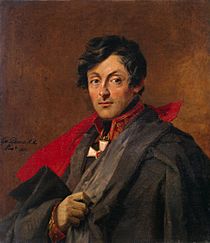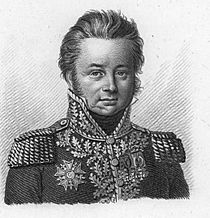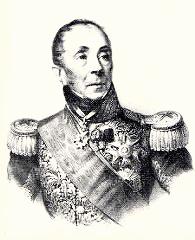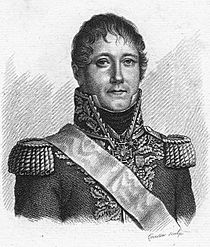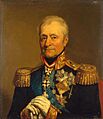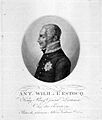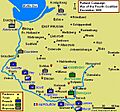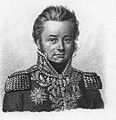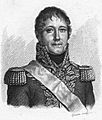Battle of Czarnowo facts for kids
Quick facts for kids Battle of Czarnowo |
|||||||
|---|---|---|---|---|---|---|---|
| Part of the War of the Fourth Coalition | |||||||
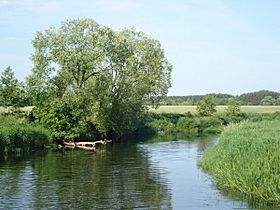 The Russian army defended the line of the Wkra River. |
|||||||
|
|||||||
| Belligerents | |||||||
| Commanders and leaders | |||||||
| Strength | |||||||
| 8,000–23,200 20 guns |
5,000–5,500 48 guns |
||||||
| Casualties and losses | |||||||
| Czarnowo: 846–1,400 Bieżuń: light Kołoząb: 518 Soldau: 221 |
Czarnowo: 853–1,401 Bieżuń: 500, 5 guns Kołoząb: unknown, 6 guns Soldau: 800, 2 guns |
||||||
The Battle of Czarnowo happened on the night of December 23-24, 1806. French soldiers, led by Emperor Napoleon, attacked Russian forces. The Russians were defending the Wkra River. Their leader was Lieutenant General Alexander Ivanovich Ostermann-Tolstoy. French troops, part of Marshal Louis-Nicolas Davout's army, crossed the Wkra River. They pushed east towards the village of Czarnowo. After fighting all night, the Russian commander pulled his soldiers back. This ended the battle, which was part of the War of the Fourth Coalition. Czarnowo is a village in Poland. It is about 33 kilometers (21 miles) north-northwest of Warsaw.
Other battles also took place that week. On December 23, Marshal Jean-Baptiste Bessières defeated Prussian troops at Bieżuń. On December 24, Marshal Pierre Augereau's army tried to cross the Wkra River at Kołoząb and Sochocin. The French managed to get across, forcing Major General Michael Andreas Barclay de Tolly's Russian defenders to retreat. On Christmas Day, part of Marshal Michel Ney's army pushed the Prussians out of Soldau (Działdowo). The Prussians had to retreat north towards Königsberg. The Russians fought hard, and two big battles happened on December 26.
Why the Battle Happened
At the Battle of Jena-Auerstedt on October 14, 1806, Napoleon's French army badly defeated the main Prussian armies. The French captured many Prussian soldiers, guns, and flags. After this, the French continued to win battles against their enemies.
In early November, French General Marc Antoine de Beaumont sent 2,500 dragoons (cavalry) to scout east of the Oder River. Napoleon wanted to stop the Russian army from reaching Warsaw. He decided to secure a position on the east side of the Vistula River before winter.
By December, the Prussian army was much smaller. Field Marshal Mikhail Kamensky led the Russian army in Poland. His army had about 90,000 men. However, Kamensky was not well and struggled to command. The Russian army was divided into two main groups. These groups were led by Generals Levin August, Count von Bennigsen and Friedrich Wilhelm von Buxhoeveden.
Napoleon moved forward with his armies. Marshal Joachim Murat's cavalry led the way. As the French advanced, General Bennigsen pulled his Russian troops back from the Vistula River. Murat took control of Warsaw on November 28. Napoleon then made Warsaw his main base for operations. Bennigsen wanted to join up with General Buxhöwden's army before fighting the full French force.
When the French crossed the Vistula in early December, Bennigsen changed his mind. He tried to take back his old positions on the east bank. But more French armies were arriving. After some small fights, Bennigsen decided to retreat behind the Wkra River.
The French soldiers were tired and unhappy in Poland. The bad weather and coming winter made them not want to continue fighting. The roads were either deep mud or frozen and bumpy. Napoleon had to give his soldiers extra pay, shirts, and shoes. Even so, military discipline got worse. Napoleon even called his soldiers "the grumblers" (les grognards).
Napoleon decided to launch a big attack. Murat's cavalry, along with armies led by Davout, Augereau, and Marshal Jean Lannes, would move north from Warsaw. Other French armies would push east from Thorn (Toruń). Their goal was to outflank the Russians and separate the Prussian army, led by General-Leutnant Anton Wilhelm von L'Estocq, from their Russian allies.
The Battle of Czarnowo
On the morning of December 23, Napoleon himself watched the Russian positions. These were near where the Wkra River flowed into the Bug-Narew River. The Wkra River split into two parts there, forming a low, swampy island. Davout's French troops had been on this island since December 20. Davout had three infantry divisions ready to fight. Napoleon decided to attack at night. He gave very detailed orders. Because Davout's generals and officers were very skilled, they followed the emperor's orders carefully.
On the other side, General Ostermann-Tolstoy held the east bank of the Wkra. He had about 5,000 to 5,500 Russian soldiers and 48 cannons. His troops were ready to defend their positions.
At 7:00 PM, French General Charles Antoine Morand's division got ready. They formed three columns, each led by one battalion. French light infantry (called voltigeurs) used boats to cross the Wkra River. They took positions on the east bank while engineers quickly built three bridges. Once the bridges were ready, Morand's troops swarmed across. The 17th Light Infantry Regiment and some cavalry were among the first to cross. Another French force also crossed the river nearby. Morand's attack was successful, and the Russians were quickly pushed out of their positions.
The 17th Light Infantry rushed forward and drove the Russians out of Czarnowo village. However, the Russians quickly regrouped and took the village back. There was a short pause as Morand brought up more French soldiers. He sent the 30th Line Infantry Regiment to attack Czarnowo again from different directions. Ostermann-Tolstoy's troops fought back and stopped this attack too. The Russian commander, worried about losing his heavy cannons, sent them to the back. The French kept attacking and finally captured Czarnowo. They then spread out east of the village.
Meanwhile, a smaller French force under General Claude Petit cleared Russian defenses near Pomiechowo. They were attacked by Russian cavalry but drove them off. Davout sent more troops to help Petit. Petit held onto the defenses even though Russian infantry attacked him. At 4:00 AM, Ostermann-Tolstoy ordered his troops to retreat. He kept attacking Petit's force to cover his withdrawal. With help from more Russian battalions and cavalry, the Russians retreated in good order to the east.
French General Louis Friant's troops were ordered to advance at 4:00 AM. They arrived soon after and took over chasing the retreating Russians from Morand's tired men. Friant's soldiers, along with Davout's light cavalry, pursued the Russians. The French captured three Russian cannons at Nasielsk. They pushed their opponents into some nearby woods. The Russians fought back fiercely. This stopped Davout's troops from advancing further than Nasielsk that day.
Ostermann-Tolstoy reported losing 500 men. Other reports say 853 Russians were killed or wounded. Three Russian generals were also wounded. Davout reported losing 807 French soldiers. The French lost many officers. Historians estimate that both sides lost about 1,400 soldiers. Some sources say French losses were 16 officers and 830 men. Russian losses were 41 officers and 1,360 men, with five cannons captured. This included 500 prisoners.
Other Battles Nearby
On December 19, Marshal Bessières' advance guard, led by General Emmanuel Grouchy's dragoons, captured Bieżuń. The Prussian commander, L'Estocq, wanted to take the town back. He sent soldiers and cannons to recapture it. This force arrived at Bieżuń on the 23rd. They found that Grouchy had many more French soldiers, including cavalry and cannons. Grouchy attacked the Prussians and pushed them back towards Soldau. The Prussians were trapped against a swampy forest. About 500 Prussian infantry and five cannons were captured. French losses were small.
As the main battle at Czarnowo ended on December 24, Augereau tried to cross the Wkra River further northwest. Kołoząb is about 10 kilometers (6 miles) northeast of Plonsk. Sochocin is 5 kilometers (3 miles) northwest of Kołoząb. Augereau had two infantry divisions and two cavalry brigades. He ordered one division to take the crossing at Kołoząb. He sent another division to take Sochocin.
The Russian commander, Barclay de Tolly, had soldiers defending both Sochocin and Kołoząb. The bridges at both places were burned. The Kołoząb crossing was defended by 12 cannons. The French attack at Sochocin failed. The soldiers could not rebuild the bridge under heavy fire. Augereau ordered a second attack, but it also resulted in more losses.
The French attack at Kołoząb was more successful. The 16th Light Infantry Regiment spread out along the west bank. Under their covering fire, French grenadiers crossed the partly destroyed bridge. They managed to get a foothold on the east bank. Russian infantry and hussars counterattacked, but the grenadiers held their ground. The French pushed back the Russians and captured six cannons. Meanwhile, another French force crossed the river further south. After this success, Augereau marched his other division to the Kołoząb crossing. French cavalry aggressively chased the Russians. They captured the baggage train of the Russian 2nd Division. Augereau reported losing 66 killed and 452 wounded. Russian losses were not reported.
Also on the 24th, Marshal Ney met a Prussian rear guard (soldiers protecting a retreating army) at Górzno. He pushed them back. The Prussian forces retreated further. Ney sent General Jean Gabriel Marchand's division towards Soldau and Mława. On December 25, Marchand attacked the Prussian battalion at Soldau with two regiments. They drove the Prussians out of the town at 2:00 PM. The rest of his division arrived later. L'Estocq attacked Soldau at about 5:00 PM. But he could not break into the town, even with hand-to-hand fighting. He retreated north to Neidenberg (Nidzica). This broke contact with the main Russian army.
Marchand commanded about 6,000 French troops and 12 cannons. The French suffered 220 casualties. The Prussian troops involved had 3,000 men and eight cannons. Prussian casualties were not reported. Ney claimed to have caused 800 casualties to his enemies and captured two cannons and one flag.
The French continued to push eastward. They fought the Russians in two major battles on December 26. At the Battle of Pułtusk, General Bennigsen with 40,600 Russian troops fought 26,000 French soldiers under Marshal Lannes. At the Battle of Gołymin, General Golitsyn and 9,000 Russians fought off Augereau's 16,000 French soldiers.
Images for kids






